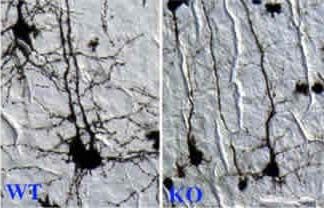Scientists Discover New Gene Essential For The Development Of Normal Brain Connections Resulting From Sensory Input

Images of neurons from normal mice (left) and from mice lacking CREST gene (right) Credit: Anirvan Ghosh
Biologists at the University of California, San Diego and the Johns Hopkins University have discovered a gene that plays a key role in initiating changes in the brain in response to sensory experience, a finding that may provide insight into certain types of learning disorders.
After birth, learning and experience change the architecture of the brain dramatically. The structure of individual neurons, or nerve cells, changes during learning to accommodate new connections between neurons. Neuroscientists believe these structural changes are initiated when neurons are activated, causing calcium ions to flow into cells and alter the activity of genes.
In a paper featured on the cover of the January 9th issue of the journal Science, biologists at UCSD and the Johns Hopkins University medical school report the discovery of the first gene, CREST, known to mediate these changes in the structure of neurons in response to calcium.
“We discovered the gene CREST using a new method we developed to identify genes that are switched on in the presence of calcium,” says Anirvan Ghosh, a professor of biology at UCSD who headed the study. “The brains of mice lacking CREST appear normal at birth, but do not develop normally in response to sensory experience after birth. This parallels some learning disorders in humans where the child appears normal initially, but by the age of two or three years it becomes clear that there are failures in the acquisition of new knowledge.”
Neurons from normal mice develop a highly branched tree-like structure. In fact, much of the growth of the brain that occurs soon after birth is the development and branching of dendrites—the part of a nerve cell that receives input from other neurons. Thus, this branching allows neurons to form many different synapses, or connections, with many other neurons, permitting much cross talk between them. Neurons taken from mice lacking the CREST gene are more linear, like a plant shoot.
In addition, when individual neurons kept alive in a Petri dish are stimulated with calcium ions, they respond by developing highly branched dendrites, but neurons taken from mice lacking CREST fail to branch in response to calcium.
“CREST is the first example of a transcription factor—a protein that turns genes on and off—that appears to be specifically required for the development of brain neurons after birth,” explains Ghosh, who conducted the study at his former laboratory at Johns Hopkins.
His new laboratory at UCSD is currently working to determine what gene is targeted by CREST. Ghosh suspects the CREST gene might be turning on the production of chemicals called growth factors, for the stimulatory effect they have on cell development.
The CREST protein produced by that gene is made in several regions of the brain immediately after birth. In adults, the protein is produced in a region of the brain known as the hippocampus, which plays an important role in learning and memory. Because of this, Ghosh suspects that CREST may be necessary for the storage of new memories and the ability to learn. His laboratory is currently developing mice in which CREST expression is normal throughout most of development, so the brain develops normally, but then shuts off in the hippocampus when the mice reach adulthood. In this way, the researchers can test the specific role of CREST in learning and memory in adults.
“Humans also have CREST, and the CREST gene sequence is highly similar between mice and humans,” says Ghosh. “If it turns out that CREST plays a role in learning and memory in the mouse, then it is very likely it also plays a similar role in humans.”
The other researchers involved in the study are Hiroyuki Aizawa, Shu-Ching Hu, Kathryn Bobb, Karthik Balakriashnan, Inga Gurevich and Mitra Cowan. The study was supported by the National Institutes of Health, the March of Dimes Birth Defects Foundation, the Klingenstein Foundation, Merck and the Uehara Memorial Foundation.
Media Contact: Sherry Seethaler (858) 534-4656
Comment: Anirvan Ghosh (858) 822-4142
Media Contact
More Information:
http://ucsdnews.ucsd.edu/newsrel/science/screst.aspAll latest news from the category: Life Sciences and Chemistry
Articles and reports from the Life Sciences and chemistry area deal with applied and basic research into modern biology, chemistry and human medicine.
Valuable information can be found on a range of life sciences fields including bacteriology, biochemistry, bionics, bioinformatics, biophysics, biotechnology, genetics, geobotany, human biology, marine biology, microbiology, molecular biology, cellular biology, zoology, bioinorganic chemistry, microchemistry and environmental chemistry.
Newest articles

Properties of new materials for microchips
… can now be measured well. Reseachers of Delft University of Technology demonstrated measuring performance properties of ultrathin silicon membranes. Making ever smaller and more powerful chips requires new ultrathin…

Floating solar’s potential
… to support sustainable development by addressing climate, water, and energy goals holistically. A new study published this week in Nature Energy raises the potential for floating solar photovoltaics (FPV)…

Skyrmions move at record speeds
… a step towards the computing of the future. An international research team led by scientists from the CNRS1 has discovered that the magnetic nanobubbles2 known as skyrmions can be…





















